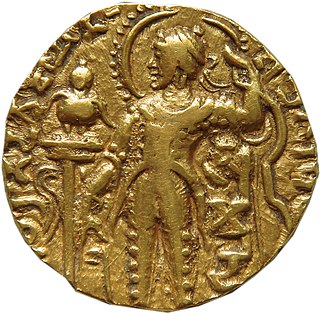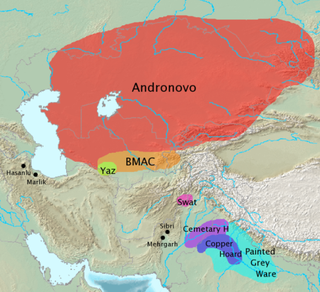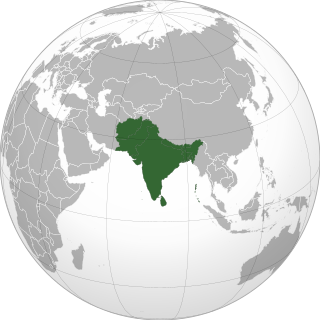The Iron Age is the final epoch of the three-age division of the prehistory and protohistory of humanity. It was preceded by the Bronze Age and the Stone Age. The concept has been mostly applied to Europe and the Ancient Near East, and, by analogy, also to other parts of the Old World.

Mehrgarh is a Neolithic site, which lies on the Kacchi Plain of Balochistan, Pakistan. Mehrgarh is located near the Bolan Pass, to the west of the Indus River valley and between the present-day Pakistani cities of Quetta, Kalat and Sibi. The site was discovered in 1974 by an archaeological team directed by French archaeologists Jean-François Jarrige and Catherine Jarrige, and was excavated continuously between 1974 and 1986, and again from 1997 to 2000. Archaeological material has been found in six mounds, and about 32,000 artifacts have been collected. The earliest settlement at Mehrgarh—in the northeast corner of the 495-acre (2.00 km2) site—was a small farming village dated between 7000 BCE and 5500 BCE.
The 18th century BC was the century which lasted from 1800 BC to 1701 BC.

The Indus Valley Civilisation (IVC) was a Bronze Age civilisation in the northwestern regions of South Asia, lasting from 3300 BCE to 1300 BCE, and in its mature form from 2600 BCE to 1900 BCE. Together with ancient Egypt and Mesopotamia, it was one of three early civilisations of the Near East and South Asia, and of the three, the most widespread, its sites spanning an area stretching from northeast Afghanistan, through much of Pakistan, and into western and northwestern India. It flourished in the basins of the Indus River, which flows through the length of Pakistan, and along a system of perennial, mostly monsoon-fed, rivers that once coursed in the vicinity of the seasonal Ghaggar-Hakra river in northwest India and eastern Pakistan.

The Indo-Gangetic Plain, also known as the Indus-Ganga Plain and the North Indian River Plain, is a 2.5-million km2 (630-million-acre) fertile plain encompassing northern regions of the Indian subcontinent, including most of northern and eastern India, the eastern parts of Pakistan, virtually all of Bangladesh and southern plains of Nepal. The region is named after the Indus and the Ganges rivers and encompasses a number of large urban areas. The plain is bound on the north by the Himalayas, which feed its numerous rivers and are the source of the fertile alluvium deposited across the region by the two river systems. The southern edge of the plain is marked by the Chota Nagpur Plateau. On the west rises the Iranian Plateau.

The Ganga basin is a part of the Ganges-Brahmaputra basin draining 1,086,000 square kilometres in Tibet, Nepal, India and Bangladesh. To the north, the Himalaya or lower parallel ranges beyond form the Ganges-Brahmaputra divide. On the west the Ganges Basin borders the Indus basin and then the Aravalli ridge. Southern limits are the Vindhyas and Chota Nagpur Plateau. On the east the Ganges merges with the Brahmaputra through a complex system of common distributaries into the Bay of Bengal. Its catchment lies in the states of Uttar Pradesh (294,364 km²), Madhya Pradesh (198,962 km²), Bihar (143,961 km²), Rajasthan (112,490 km²), West Bengal (71,485 km²), Haryana (34,341 km²), Himachal Pradesh (4,317 km²), Delhi, Arunachal pradesh(1,484 km²), the whole of Bangladesh, Nepal and Bhutan. Several tributaries rise inside Tibet before flowing south through Nepal. The basin has a population of more than 500 million, making it the most populated river basin in the world.

The history of metallurgy in the Indian subcontinent began prior to the 3rd millennium BCE and continued well into the British Raj. Metals and related concepts were mentioned in various early Vedic age texts. The Rigveda already uses the Sanskrit term Ayas(आयस) (metal). The Indian cultural and commercial contacts with the Near East and the Greco-Roman world enabled an exchange of metallurgic sciences. With the advent of the Mughals, India's Mughal Empire further improved the established tradition of metallurgy and metal working in India.

The Ochre Coloured Pottery culture (OCP) is a 4th millennium BC to 2nd millennium BC Bronze Age culture of the Indo-Gangetic Plain, extending from eastern Punjab to northeastern Rajasthan and western Uttar Pradesh. It is considered a candidate for association with the early Indo-Aryan or Vedic culture.

The Painted Grey Ware culture (PGW) is an Iron Age Indian culture of the western Gangetic plain and the Ghaggar-Hakra valley in the Indian subcontinent, conventionally dated c.1200 to 600–500 BCE, though newer publications have suggested a range of 1500 to 700 BCE, or from 1300 to 500–300 BCE. It is a successor of the Cemetery H culture and Black and red ware culture (BRW) within this region, and contemporary with the continuation of the BRW culture in the eastern Gangetic plain and Central India.

The Gandhara grave culture, also called Swat culture, or Swat Protohistoric Graveyards Complex, emerged c. 1400 BCE and lasted until 800 BCE, and there are no burials with these features after 800 BCE, as new fieldwork reveals. It is found basically in Middle Swat River course, even though earlier research considered it to be expanded to the Valleys of Dir, Kunar, Chitral, and Peshawar. It has been regarded as a token of the Indo-Aryan migrations, but has also been explained by local cultural continuity. Backwards projections, based on ancient DNA analyses, suggest ancestors of Swat culture people mixed with a population coming from Inner Asia Mountain Corridor, which carried Steppe ancestry, sometime between 1900 and 1500 BCE.

The Northern Black Polished Ware culture is an urban Iron Age Indian culture of the Indian Subcontinent, lasting c. 700–200 BCE, succeeding the Painted Grey Ware culture and Black and red ware culture. It developed beginning around 700 BCE, in the late Vedic period, and peaked from c. 500–300 BCE, coinciding with the emergence of 16 great states or mahajanapadas in Northern India, and the subsequent rise of the Mauryan Empire.
Several periodisations are employed for the periodisation of the Indus Valley Civilisation. While the Indus Valley Civilisation was divided into Early, Mature and Late Harappan by archaeologists like Mortimer Wheeler, newer periodisations include the Neolithic early farming settlements, and use a Stage-Phase model, often combining terminology from various systems.

In the prehistory of the Indian subcontinent, an "Iron Age" is recognized as succeeding the Late Harappan culture. The main Iron Age archaeological cultures of present-day northern India are the Painted Grey Ware culture and the Northern Black Polished Ware. This corresponds to the transition of the Janapadas or principalities of the Vedic period to the sixteen Mahajanapadas or region-states of the early historic period, culminating in the emergence of the Maurya Empire towards the end of the period.

Pottery in the Indian subcontinent has an ancient history and is one of the most tangible and iconic elements of Indian art. Evidence of pottery has been found in the early settlements of Lahuradewa and later the Indus Valley Civilization. Today, it is a cultural art that is still practiced extensively in Indian subcontinent. Until recent times all Indian pottery has been earthenware, including terracotta.

Bhirrana, also Bhirdana and Birhana, is an archaeological site, located in a small village in Fatehabad District, in the Indian state of Haryana. Its history stretches back to pre-Indus Valley Civilisation times, as revealed by archaeological discoveries, dating to the 8th-7th millennium BCE. The site is one of the many sites seen along the channels of the seasonal Ghaggar river, thought by some to be the Rigvedic Saraswati river.

The Vedic period, or Vedic age, is the period in the late Bronze Age and early Iron Age of the history of India when the Vedas were composed in the northern Indian subcontinent, between the end of the urban Indus Valley Civilisation and a second urbanisation which began in the central Indo-Gangetic Plain c. 600 BCE. The Vedas are liturgical texts which formed the basis of the influential Brahmanical ideology, which developed in the Kuru Kingdom, a tribal union of several Indo-Aryan tribes. The Vedas contain details of life during this period that have been interpreted to be historical and constitute the primary sources for understanding the period. These documents, alongside the corresponding archaeological record, allow for the evolution of the Indo-Aryan and Vedic culture to be traced and inferred.

The Ahar culture, also known as the Banas culture is a Chalcolithic archaeological culture on the banks of Ahar River of southeastern Rajasthan state in India, lasting from c. 3000 to 1500 BCE, contemporary and adjacent to the Indus Valley Civilization. Situated along the Banas and Berach Rivers, as well as the Ahar River, the Ahar–Banas people were exploiting the copper ores of the Aravalli Range to make axes and other artefacts. They were sustained on a number of crops, including wheat and barley.
Bara Culture was a culture that emerged in the eastern region of the Indus Valley Civilization around 2000 BCE. It developed in the doab between the Yamuna and Sutlej rivers, hemmed on its eastern periphery by the Shivalik ranges of the lower Himalayas. This territory corresponds to modern-day Punjab, Haryana and Western Uttar Pradesh in North India. Baran culture is believed to have initially developed independently of the Harappan culture branch of the Indus Valley Civilization from a pre-Harappan tradition, although the two cultures later intermingled in locations such as Kotla Nihang Khan and Bara, Punjab. In the conventional timeline demarcations of the Indus Valley Tradition, the Bara culture is usually placed in the Late Harappan period.

Chirand is an archaeological site in the Saran district of Bihar, India, situated on the northern bank of the Ganga River. It has a large pre-historic mound which is known for its continuous archaeological record from the Neolithic age to the reign of the Pal dynasty who ruled during the pre-medieval period. The excavations in Chirand have revealed stratified Neolithic, Chalcolithic, and Iron Age settlements, and transitions in human habitation patterns dating from 2500 BC to 30 AD.

The Reh Inscription was discovered in 1979 near the Reh archaeological site along Yamuna River about 350 kilometres (220 mi) east of Mathura in India. It is a Prakrit inscription in Brahmi script near the bottom of a Shiva linga. The inscription is dated to between the 2nd century BCE and 2nd century CE based on the script style.

















